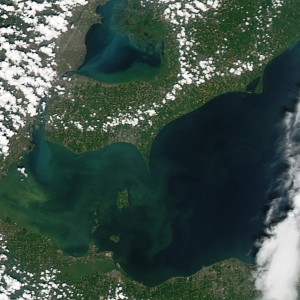Lake Erie Utilities and Organizations React to Algae Toxins in Drinking Water
Toledo crisis prompts calls for action, purchases of testing equipment to safeguard public health.
By Codi Kozacek
Circle of Blue
Communities that draw their drinking water from Lake Erie are spending thousands of dollars to test for and treat algal toxins like those that contaminated the water supply this month for more than 400,000 people in Toledo, Ohio. The costs are growing, but water managers say they are left with little choice when it comes to ensuring safe water.
The responses by water utilities came amid a flurry of action to address the growing toxic threat across the Great Lakes Basin. They included:
- Chicago Mayor Rahm Emanuel on Wednesday called on Great Lakes mayors to come together for a summit, likely in the fall, to develop a strategy to clean up the Great Lakes in the wake of the Toledo water crisis. “Access to clean drinking water is something that all residents expect when they turn on the tap,” said Emanuel. “By convening the leaders of the municipalities that depend on this fresh water supply, we can most effectively discuss the strategies necessary to protect this vital water source for years to come.”
- Engineers at the National Aeronautics and Space Administration’s Glenn Research Center in Cleveland launched a flight campaign on Tuesday to deploy NASA Glenn remote sensing technology, previously developed for Mars exploration, to learn more about the Lake Erie algal bloom. The technology — a hyper-spectral imager and miniature spectrometers – were taken aboard Glenn’s S-3 aircraft. Researchers from Glenn; the National Oceanic and Atmospheric Administration Great Lakes Environmental Research Laboratory (GLERL) in Ann Arbor, Michigan and the U.S. Naval Research Laboratory in Washington, D.C. are using the high-resolution instruments to capture images that will reveal western Lake Erie’s characteristics across the light spectrum. “By studying these signatures, researchers can continually improve their ability to remotely identify the biochemical properties of an algal bloom and predict when and where they will form,” said NASA in a statement.
- A Great Lakes business association, and seven Great Lakes and national environmental organizations called for “swift action by the governors of Great Lakes states and the premier of Ontario to implement measurable reductions in nutrients, particularly phosphorus, on a clear timetable to protect our region’s health, economy and quality of life.” The groups that issued the declaration are the Alliance for the Great Lakes, American Rivers, Environment Ohio, Freshwater Future , Lake Erie Charter Boat Association, Lake Erie Waterkeeper Inc., Ohio Environmental Council, National Wildlife Federation, and the Sierra Club.
“This event’s a game changer for the often-overlooked Great Lakes region,” wrote Tom Henry, a widely respected environmental reporter for The Toledo Blade. “It not only proved the unthinkable can happen. It also serves as a stiff wake-up call about the hidden costs of pollution and how our lives are fundamentally connected to water.”
Blooms of toxin-releasing cyanobacteria, called blue-green algae, are a persistent and growing problem in Lake Erie. The lake provides drinking water to approximately 11 million people, and harmful blooms have now contaminated the water supply and forced “Do Not Drink” advisories for two water treatment plants in Ohio—Carroll Township in September 2013, and Toledo on Saturday. Testing for the toxin released by the bloom, which can cause nausea, vomiting and liver damage if ingested, is recommended but not required. Nonetheless, many Lake Erie water utilities are testing for it voluntarily.
Testing requires utilities to take water samples from their source water and from their final, treated water. Most water plants do not have the equipment needed to test for the toxin, microcystin, themselves, so the samples are sent to labs at larger plants. Along Lake Erie, many of the samples are sent to the Oregon, Ohio, water treatment plant. If microcystin is detected in the samples, the plants begin treating their water with a variety of chemicals—namely chlorine, ozone or activated carbon—to destroy the toxin.
Utilities Pursue Testing Upgrades
Following the Toledo incident, several Lake Erie communities are considering investments in microcystin testing equipment to improve their ability to detect the toxin quickly. These communities include Monroe, Mich., and Sandusky, Ohio. The equipment costs between $US 8,000 and $US 10,000, but also requires the purchase of chemical testing kits, called Elisa kits, that cost around $US 400. Each kit can test a number of samples. The Oregon treatment plant provides its testing service free of charge to other utilities, but requires them to purchase the chemical reagents used in the tests.
“Some [treatment plants] are not charging, and others are charging $50 per sample,” Doug Keller, water services superintendent for Sandusky, told Circle of Blue. “We do three samples per day—the raw water coming in, and then at our two finished water pump houses that pump water to the city.”
Keller and other water managers in the region said they had been testing about once a week before Toledo’s water advisory; now all are testing once a day. “Starting May 6, we tested once a week up to this Saturday when at 8:30am my phone blew up and everybody was worried, and rightfully so, about Sandusky’s water,” Keller said. “I plan to test every day until I get two days of consecutive non-detections from the raw [water], the satellite imagery from MODIS looks clear and the HAB [harmful algal bloom] forecast from NOAA doesn’t indicate anything, and our lab surveys are clear. All of those things and then we’ll drop back down to once a week.”
Kelly Frey, sanitary engineering department head for Ottawa County, Ohio, said the Ottawa County regional water treatment plant is also sampling for Microcystin once a day. “We have a protocol where we test once a week until we detect [microcystin] in the raw water,” Frey told Circle of Blue. “If it is below 1 [part per billion] in the raw water, at that point we start testing three times a week. Now, Oregon has upped their testing to once a day, and we are going to take our samples to Oregon once a day.”
Frey said there are no definite plans yet, but ideas have been floated about increasing the number of water plants that have their own testing equipment instead of relying on a few regional locations.
Treatment Chemicals: Large and Growing Cost
The real costs of microcystin for water utilities, however, come during water treatment. The Ottawa County regional plant, which treats 9 million gallons of water each day, spent $US 50,000 to remove the toxin last year, according to Frey. Similarly, Monroe, Mich., spent $US 60,000 fighting 2011’s record-setting algal bloom. Sandusky has budgeted $US 33,836 for powdered activated carbon this year.
“And I’ll use every bit of that,” Keller said.
He has also had to increase the amount he spends on sodium permanganate, now $US 95,000, because he increases the amount used when toxins are present. Out of the $US 306,000 the utility spends on aluminum sulfate, he estimates $US 100,000 is used for algal toxins. When algae contamination is a possibility, precautionary treatment can also use resources.
“You have to understand that when you grab samples, it is just a picture of what is going on at the moment,” Keller said. “I could grab a sample, walk to the lab, and prepare it for testing, and by that time I could have toxins coming in. So I just set the treatment process as if there are toxins coming in all the time.”
The cost of the treatment chemicals is also growing, Keller added, saying it has gone up every year for the past several years. In Toledo, for example, the city’s annual budget for treatment chemicals nearly doubled between 2010 and 2013, reaching $US 4 million.
Legislation specifically targeting chemical costs and testing upgrades has not yet been introduced in Ohio, though a recent budget line item will send $US 10 million to the Healthy Lake Erie Initiative—a program focused on addressing harmful algal blooms and the disposal of contaminated harbor dredge material. The Lake Erie Caucus, formed in December 2013 by state senators Randy Gardner and Capri Cafaro, will be meeting August 15 to discuss issues related to the harmful algal blooms.
A news correspondent for Circle of Blue based out of Hawaii. She writes The Stream, Circle of Blue’s daily digest of international water news trends. Her interests include food security, ecology and the Great Lakes.
Contact Codi Kozacek












Leave a Reply
Want to join the discussion?Feel free to contribute!